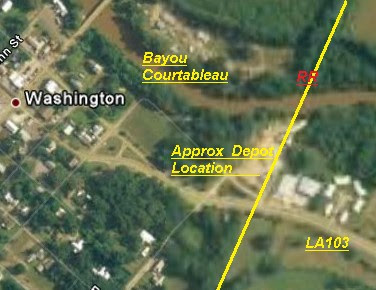We continued on into Washington on La.103. I took the first street west and then looked for a street that went south, the believed location of the right of way. I've combed Washington before and was denied by this blocked bridge.
We came to the same blocked bridge.
We dismounted. Neighborhood houses were on either side of the street. I envisioned people peering from the curtains. The blocked bridge lay ahead. I've gotten a little tentative about trespassing lately. The clock runs down on good luck and Mike says that they only have collected 10 bucks in my bail money account.
Then I thought for a moment. This was a public bridge that was merely blocked, albeit with menacing signs. It did not belong to anyone but the town. I was still a little nervous about prowling around it as I know Washington has an aggressive police force, just try speeding near the Washington exit on I-49.
A woman was working in her yard, far off the street.
Al said to ask her. I waved my hands explaining that I was an old train nut and was this the location of the railroad that went through Washington. That approach has rarely had a positive conclusion. But, She smiled and said, "Yes, this is it".
I think I went, "huh?", not believing our good fortune. I asked her where the depot was. She said, "the section house depot was right here, let me show you the stairs the men would use to go down to the trains".
I was reeling, morphing into a happy puppy as we followed along.
Stop the presses, it is show and tell time.
Some explanation is in order.
"Section house" is the first. Scanning the web, I found one I could use from Texas that even had a little definition with it. Don't pay any attention to the "toll booth" mentioned.

Here's another version:

Here's my favorite, the section crew. I guess these guys kept the rails right.

And, this is the very rare picture of the Washington Depot. She said it had been down by the bayou near La.103. I had guessed that. It was near where the rock hauling business is today. Being close to the bayou, it could have been a transfer spot. Also, it would have been on flat land with no need of steps to descend to get to the platform. The picture was taken in the early 1900's. That is a Southern Pacific train. It would have come from Alexandria by way of Cheneyville or as far away as Avery Island and beyoud. Actually, you know it could have come from a number of places in southwest Louisiana. Could that be a Conductor standing on the platform getting ready to board?

The layout was this. I'm not showing the location of the overpass as our host and her husband, 5 Rottweiler dogs and male twins, age 2, do not invite visitors. The dogs were friendly, but well trained. The children were neither.

The rail bed overpass was needed because the Southern Pacific had to dig its way through Washington. The incline coming from the two bayous it crosses, Bayou Caron and Bayou Courtableau, is too great for those trains to scale, thus the sunken right of way.
The hurricane had dropped trees into the dig and I was unable to get down there. Actually I could have but feared the embarrassment of not being able to return to the surface with our host looking on. She made the point that she could get down there a couple of times which did no good to my manly pride. I told her I would, but not in my new jeans. I know, that was pretty lame. I settled for these unmanly pictures.
Here's the aforementioned steps from the section house to the rails.
.jpg)
.jpg)
Pictured is the surface of the bridge. I cannot believe this is all I have. Notice the heavy iron piece just outside the railing. What is that all about? Did it have a railroad function? I have to go back. Al, you coming? Yes, you can tell her that your Grandma was a Fontenot while I climb down into the trench. I'm so glad you saved that story.
.jpg)
Seen is only half of the bridge. It was quite a span. The iron might be a support pan for the unsupported stretch over the rails. I'm not satisfied with that guess. To keep the wooden bridge from igniting, an iron underbelly might have been required. Now there's a far out guess. I just talked to Everett, he verified that my guess was far out. But, to make me feel better, he did say that a mine had caught fire. I may have the story mixed up.
.jpg)
While talking, Everett sent this drawing of the LeCompte section house seeing I didn't have a local one.

This was the section car house, the "car" was used for railroad work. I'll get him to elaborate later, which he will, in lenght. You will know more about a section car than you though possible.

These were Red River and Gulf buildings in LeCompte. They were part of the railroad which was based at Longleaf where the Southern Forest Heritage Museum is now located. You might want to check out the Great Depot Adventure for a look at where this stuff was probably located.
That's it until I can return. This one is NOT OVER.